卡尔费休水分测定仪性能确认
- 格式:docx
- 大小:27.43 KB
- 文档页数:7
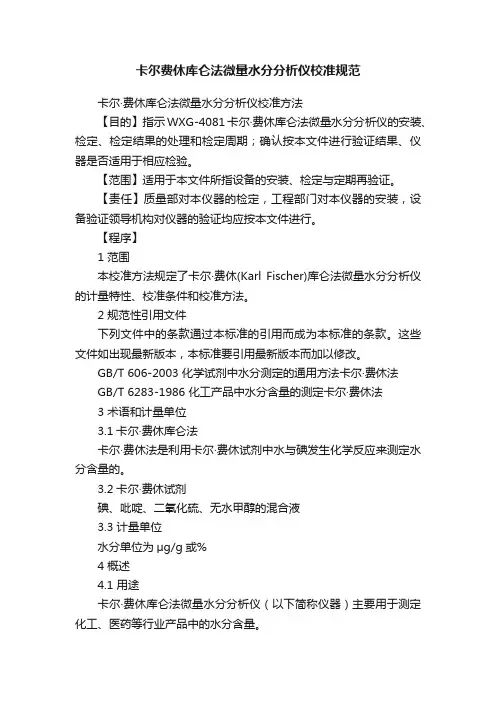
卡尔费休库仑法微量水分分析仪校准规范卡尔·费休库仑法微量水分分析仪校准方法【目的】指示WXG-4081卡尔·费休库仑法微量水分分析仪的安装、检定、检定结果的处理和检定周期;确认按本文件进行验证结果、仪器是否适用于相应检验。
【范围】适用于本文件所指设备的安装、检定与定期再验证。
【责任】质量部对本仪器的检定,工程部门对本仪器的安装,设备验证领导机构对仪器的验证均应按本文件进行。
【程序】1 范围本校准方法规定了卡尔·费休(Karl Fischer)库仑法微量水分分析仪的计量特性、校准条件和校准方法。
2 规范性引用文件下列文件中的条款通过本标准的引用而成为本标准的条款。
这些文件如出现最新版本,本标准要引用最新版本而加以修改。
GB/T 606-2003 化学试剂中水分测定的通用方法卡尔·费休法GB/T 6283-1986 化工产品中水分含量的测定卡尔·费休法3 术语和计量单位3.1卡尔·费休库仑法卡尔·费休法是利用卡尔·费休试剂中水与碘发生化学反应来测定水分含量的。
3.2卡尔·费休试剂碘、吡啶、二氧化硫、无水甲醇的混合液3.3 计量单位水分单位为μg/g或%4 概述4.1 用途卡尔·费休库仑法微量水分分析仪(以下简称仪器)主要用于测定化工、医药等行业产品中的水分含量。
4.2 原理卡尔·费休试剂同水反应的化学方程式为:H2O+I2+SO2+3C5H5N→2C5H5N·HI+C5H5N·SO3C5H5N·SO3+CH3OH→C5H5N·HSO4CH3在电解过程中,电极反应如下:阳极:2I--2e→I2阴极:I2+2e→2I-2H++2e→H2↑从以上反应中可以看出,即1摩尔的碘氧化1摩尔的二氧化硫,需要1摩尔的水。
所以是1摩尔碘与1摩尔水的当量反应,即电解碘的电量相当于电解水的电量,电解1摩尔碘需要2×96493库仑电量,电解1毫摩尔水需要电量为96493毫库仑电量。

卡尔费休⽒微量⽔份测定仪的标准操作规程卡尔费休⽒微量⽔份测定仪的标准操作规程⽬的:建⽴卡尔费休⽒微量⽔分测定仪的标准操作规程,指导正确使⽤该仪器。
范围:适⽤于卡尔费休⽒微量⽔分测定仪的操作。
职责:检验⼈员对本规程的实施负责。
1.程序:1.1仪器的连接1.1.1给排液系统的连接:按照说明书的⽰意图进⾏连接。
1.1.2主机、打印机、搅拌系统的连接:按说明书连接好各部件的连线及电源。
1.1.3滴定管的安装与拆卸1.1.3.1安装:将滴定管沿着主机轨道向左推进,待各部件都吻合后锁紧螺母。
1.1.3.2如需拆卸,按“回零”键待滴定管处于归位状态后,拧开螺母,将滴定管向右推出即可。
1.1.4安装好滴定管与卡尔费休试液的连接,打开电源开关。
1.2实验前准备1.2.1滴定杯溶剂的加⼊:按⾃动给液系统操作进液,给滴定杯加⼊滴定剂(⼀般为⽆⽔甲醇)约40ml左右,以将电极浸泡为准。
1.2.2清洗:每次试验前或新滴定管要清洗管路,按“清洗”键设置参数,清洗次数设为1次,清洗体积为10ml;若更换滴定液后,清洗次数设为2~3次即可。
为节约卡⽒液可将出液管放⼊原滴定剂瓶中,清洗完成后将出液管插⼊滴定杯中。
准备开始试验。
1.2.3搅拌:打开搅拌台电源,按“”搅拌,“”为增⼤搅拌速度,“”为减⼩搅拌速度,调到溶液呈漩涡状即可。
注意速度不要调太快,以免溶剂飞溅影响结果,同时在实验过程中不要调整转速。
1.3实验员登录在实验中如要求将实验员名称及实验室信息显⽰在实验报告上,此时就需要在系统中设置。
1.3.1建⽴新的实验员使⽤该仪器,需要设置⼀⽤户名。
按“选择”键进⼊出现实验员登录项下,1.3.2系统设置:确认后输⼊密码:97299确认后,界⾯出现01[实验室信息]按“↓”进⼊02[操作员信息],按“启动”键设置。
1.3.3⽤户名称设置:在出现“⽤户名称01”,按“滴参”键输⼊区位码,在区位码⼿册查找⾃⼰姓名编码输⼊,完毕后确认输⼊密码,最多为4位;多个⽤户名设置按照同样⽅法设置,记住每⽤户名的序号和密码。
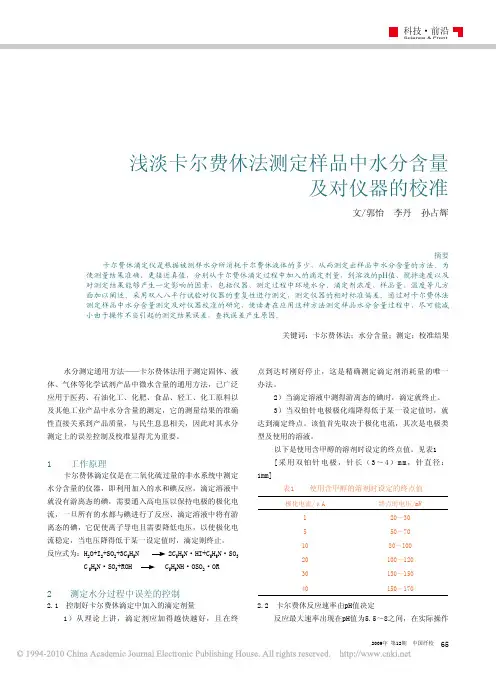
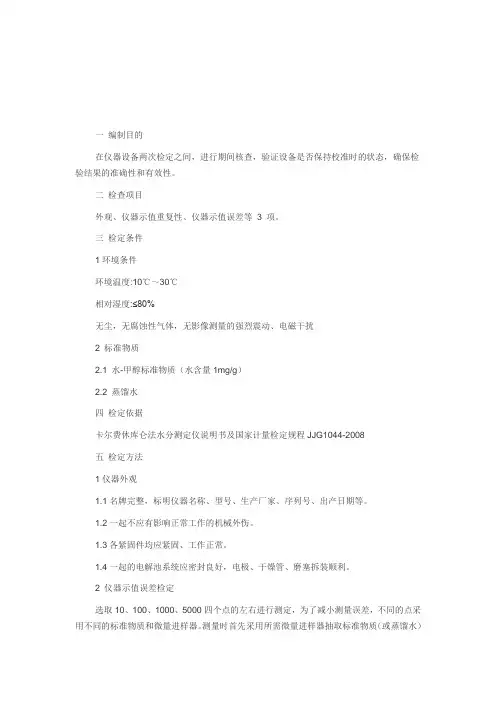
一编制目的在仪器设备两次检定之间,进行期间核查,验证设备是否保持校准时的状态,确保检验结果的准确性和有效性。
二检查项目外观、仪器示值重复性、仪器示值误差等3 项。
三检定条件1环境条件环境温度:10℃~30℃相对湿度:≤80%无尘,无腐蚀性气体,无影像测量的强烈震动、电磁干扰2 标准物质2.1 水-甲醇标准物质(水含量1mg/g)2.2 蒸馏水四检定依据卡尔费休库仑法水分测定仪说明书及国家计量检定规程JJG1044-2008五检定方法1仪器外观1.1名牌完整,标明仪器名称、型号、生产厂家、序列号、出产日期等。
1.2一起不应有影响正常工作的机械外伤。
1.3各紧固件均应紧固、工作正常。
1.4一起的电解池系统应密封良好,电极、干燥管、磨塞拆装顺利。
2 仪器示值误差检定选取10、100、1000、5000四个点的左右进行测定,为了减小测量误差,不同的点采用不同的标准物质和微量进样器。
测量时首先采用所需微量进样器抽取标准物质(或蒸馏水)至所需刻度,在分析天平上称量进样针的质量W1然后进样,进样器针头必须进入到电解液面一下,全部注入试样后拔出,擦干进样器粘的电解液称量进样针质量W2,分别对不同含水量的标准物质测量三次,检定点的测量值与标准值之差的平均值即为仪器的示值误差。
不同的检定点采用不同的微量进样器:示值误差计算公式:式中:Δx-----示值误差,μg;xi------检定点的测量值,μg;xs------检定点的标准值,μg。
3 仪器示值重复性检定当仪器稳定后,用10μl微量进样器注入10μl水-甲醇标准物质。
连续进样6次,记录测量值,定量重复性以含水量测量结果的相对标准偏差RSD表示:式中: RSD—相对标准偏差,%;n—测量次数;xi—第i次测量值。
六评定标准所测得仪器的示值误差不超过±(5%检定点)μg;100μg点的测量值的相对偏差不大于3%;外观正常。
七核查周期在仪器设备两次检定之间,一般每隔六个月核查一次。
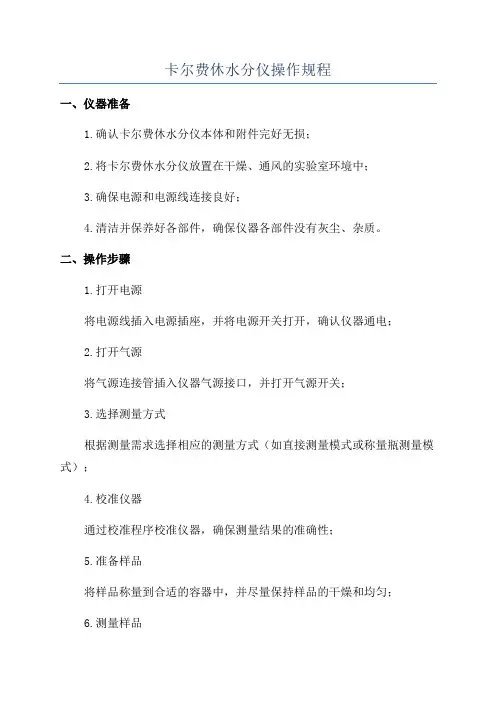
卡尔费休水分仪操作规程一、仪器准备1.确认卡尔费休水分仪本体和附件完好无损;2.将卡尔费休水分仪放置在干燥、通风的实验室环境中;3.确保电源和电源线连接良好;4.清洁并保养好各部件,确保仪器各部件没有灰尘、杂质。
二、操作步骤1.打开电源将电源线插入电源插座,并将电源开关打开,确认仪器通电;2.打开气源将气源连接管插入仪器气源接口,并打开气源开关;3.选择测量方式根据测量需求选择相应的测量方式(如直接测量模式或称量瓶测量模式);4.校准仪器通过校准程序校准仪器,确保测量结果的准确性;5.准备样品将样品称量到合适的容器中,并尽量保持样品的干燥和均匀;6.测量样品将样品容器插入仪器样品槽中,并按下开始测量按钮进行测量;7.查看测量结果等待测量完成后,查看仪器显示屏上的测量结果;8.记录数据将测量结果记录在实验记录本或电脑中,包括样品编号、测量时间、测量数值等;9.清洁仪器测量完毕后,将样品容器取出并清洁仪器的样品槽和相关配件,确保仪器处于洁净状态;10.关闭气源和电源关闭气源开关,断开气源连接管;将电源开关关闭,并将电源线拔出电源插座。
三、常见问题与解决方法1.仪器显示异常可能原因:电源接触不良、电源线有问题、仪器故障等;2.测量结果波动大可能原因:样品不均匀、气源问题等;解决方法:将样品均匀搅拌,确认气源稳定;3.测量结果不准确可能原因:仪器未校准、样品容器不合适等;解决方法:根据校准程序进行校准,选择合适的样品容器。
四、注意事项1.操作人员应具备相关仪器使用和安全知识,按照操作规程进行操作;2.操作时需戴好防护手套,避免溶液直接接触皮肤;4.样品应该干燥且均匀,避免过多水分对测量结果的影响;5.操作完成后应及时清洁仪器,保持仪器的清洁和正常工作状态。
五、维护保养1.每次使用结束后要及时清洁仪器外观和内部结构,除去灰尘和杂质;2.定期检查仪器的电源和电源线,确保连接良好;3.定期校准仪器,以保证测量结果的准确性;4.在仪器长时间不使用时,应将其断电并进行适当的保护。
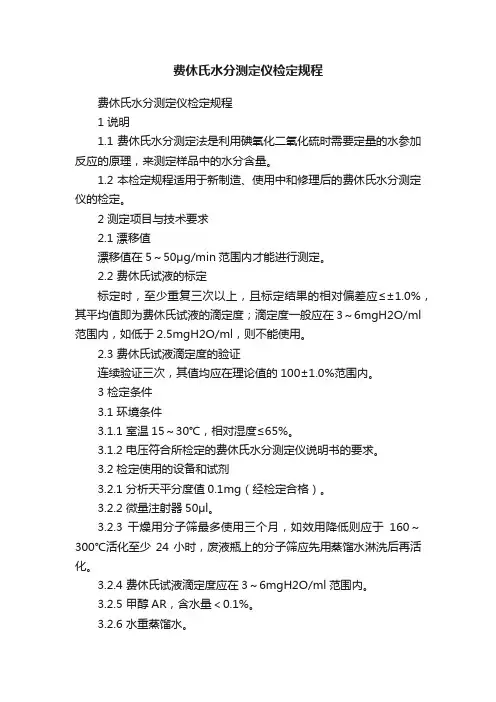
费休氏水分测定仪检定规程费休氏水分测定仪检定规程1 说明1.1 费休氏水分测定法是利用碘氧化二氧化硫时需要定量的水参加反应的原理,来测定样品中的水分含量。
1.2 本检定规程适用于新制造、使用中和修理后的费休氏水分测定仪的检定。
2 测定项目与技术要求2.1 漂移值漂移值在5~50μg/min范围内才能进行测定。
2.2 费休氏试液的标定标定时,至少重复三次以上,且标定结果的相对偏差应≤±1.0%,其平均值即为费休氏试液的滴定度;滴定度一般应在3~6mgH2O/ml 范围内,如低于2.5mgH2O/ml,则不能使用。
2.3 费休氏试液滴定度的验证连续验证三次,其值均应在理论值的100±1.0%范围内。
3 检定条件3.1 环境条件3.1.1 室温15~30℃,相对湿度≤65%。
3.1.2 电压符合所检定的费休氏水分测定仪说明书的要求。
3.2 检定使用的设备和试剂3.2.1 分析天平分度值0.1mg(经检定合格)。
3.2.2 微量注射器50μl。
3.2.3 干燥用分子筛最多使用三个月,如效用降低则应于160~300℃活化至少24小时,废液瓶上的分子筛应先用蒸馏水淋洗后再活化。
3.2.4 费休氏试液滴定度应在3~6mgH2O/ml范围内。
3.2.5 甲醇AR,含水量<0.1%。
3.2.6 水重蒸馏水。
3.2.7 酒石酸钠二水物。
3.2.8 所用仪器均应洁净干燥,并避免空气中水气的侵入,测定操作应在干燥处进行。
4 检定方法4.1 检定前的准备4.1.1 打开主机电源开关及打印机电源开关,输入检定日期和时间,按照仪器规定的程序操作。
4.1.2 首先自动快速抽排一次,以清洗滴定系统和排除管路中的气泡;更换新的费休氏试液时需清洗管路,至少抽排两次。
4.1.3 调节搅拌速度调节钮,使搅拌棒以合适的速度旋转,在滴定过程中不得随意改变搅拌速度。
4.1.4 进行预滴定以消除溶剂空白。
4.2 漂移值得测定令仪器自动测定并打印出漂移值。
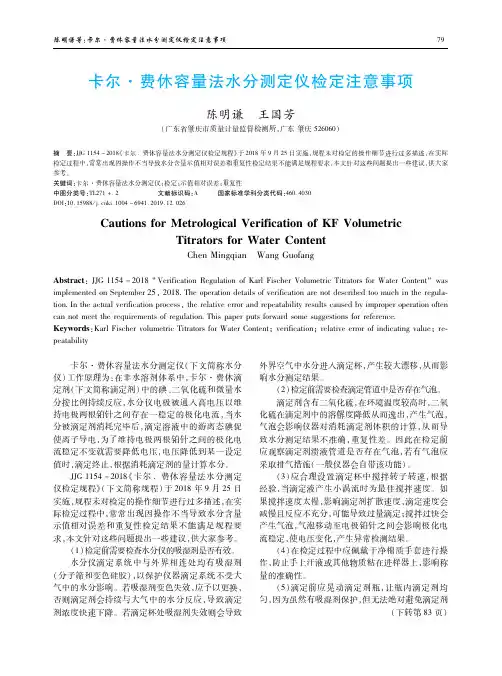
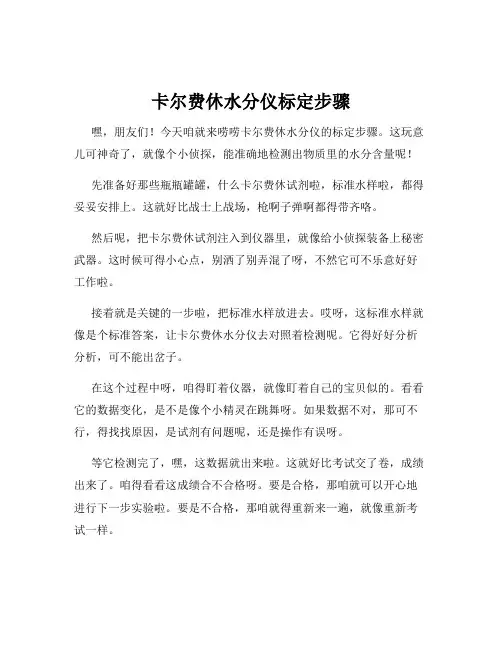
卡尔费休水分仪标定步骤嘿,朋友们!今天咱就来唠唠卡尔费休水分仪的标定步骤。
这玩意儿可神奇了,就像个小侦探,能准确地检测出物质里的水分含量呢!先准备好那些瓶瓶罐罐,什么卡尔费休试剂啦,标准水样啦,都得妥妥安排上。
这就好比战士上战场,枪啊子弹啊都得带齐咯。
然后呢,把卡尔费休试剂注入到仪器里,就像给小侦探装备上秘密武器。
这时候可得小心点,别洒了别弄混了呀,不然它可不乐意好好工作啦。
接着就是关键的一步啦,把标准水样放进去。
哎呀,这标准水样就像是个标准答案,让卡尔费休水分仪去对照着检测呢。
它得好好分析分析,可不能出岔子。
在这个过程中呀,咱得盯着仪器,就像盯着自己的宝贝似的。
看看它的数据变化,是不是像个小精灵在跳舞呀。
如果数据不对,那可不行,得找找原因,是试剂有问题呢,还是操作有误呀。
等它检测完了,嘿,这数据就出来啦。
这就好比考试交了卷,成绩出来了。
咱得看看这成绩合不合格呀。
要是合格,那咱就可以开心地进行下一步实验啦。
要是不合格,那咱就得重新来一遍,就像重新考试一样。
你们说这卡尔费休水分仪是不是很有意思呀?它就像个聪明的小助手,帮我们准确地检测水分呢。
咱可得好好对待它,按照步骤一步一步来,可不能马虎大意哟。
不然它发起脾气来,可不好哄呢!大家想想,要是没有它,我们怎么能知道那些东西里到底有多少水分呢?所以呀,学会使用它,掌握好标定步骤,那可是非常重要的呢。
在实际操作中呀,可别嫌麻烦,每一步都得认真对待。
就像盖房子,根基打不好,房子可就不牢固啦。
这卡尔费休水分仪的标定步骤也是一样,一步都不能错,一步都不能省。
总之呢,卡尔费休水分仪的标定步骤虽然有点繁琐,但只要咱认真学,认真做,就一定能掌握好。
到时候呀,咱就能轻松地检测出各种物质里的水分含量啦。
大家加油哦!。

KF-1A型水份测定仪使用说明书中国姜堰市银河仪器厂江苏KF-1A水份测定仪说明书一、原理:本仪器为卡尔·费休(Kart Fischer)容量滴定法测定水份含量的仪器,采用“永停法”来确定终点,。
根据半电池反应:I2+2e<=>2Iˉ溶液中同时存在I2及Iˉ时上述反应分别在两个电极上进行,既在一个电极上I2被还原,而再另一个电极上Iˉ被氧化,因此在两个电极之间有电流通过。
如果溶液中只有Iˉ而无I2则电极间无电流通过。
当滴定终点时溶液中有微量卡尔·费休试剂存在,即有Iˉ及I2同时存在,这时溶液导电,仪器显示滴定到达终点。
反应式:I2+SO2+3C5H5N+CH3OH+H2O→2C4H5N.HI+C5H5N.HSO4CH3根据滴定反应中所消耗的卡尔·费休试剂量来算出样品中水份的含量。
二、仪器性能及适应范围:1、仪器性能:a、测量范围:30×10ˉ6~100%。
b、以水为标样,测定卡尔·费休试剂的水当量,平行测定相对误差≤3%。
c、电源电压:交流220±10%。
2、适应范围:本仪器主要用于测定化肥、医药、食品、轻工、化工原料以及其它工业产品中的水份含量。
根据资料及美国材料协会标准ASTM,使用卡尔·费休法可直接测定的化合物包括:有机化合物-饱和的不饱和的碳氢化合物,缩醛、酸类、酰基卤、醇类、稳定的酰、酰胺、弱的胺、酐、二硫化物、酯类、醚卤化物、碳氢化合物,稳定的酮、过氧化物,原酸酯,亚硫酸盐、硫氰酸盐及硫醚等。
无机化合物-酸、酸性氧化物、氧化铝、酐、过氧化钡、碳化钙、氧化铜、干燥剂、硫酸肼、部分有机和无机酸的盐等。
测定水份含量在0.1%-10%时,选用10毫升滴定管(最小分度为0.05毫升)。
测定水份含量<0.1%时,应适当增大取样量并可选用5毫升或2毫升滴定管(最小分度为0.02毫升)。
测定水份含量>10%时,应适当减小取样量并可选用25毫升滴定管(最小分度为0.05毫升)。
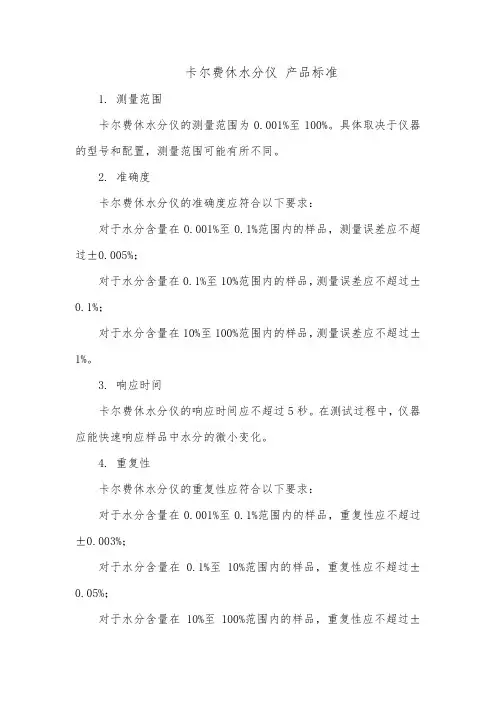
卡尔费休水分仪产品标准1. 测量范围卡尔费休水分仪的测量范围为0.001%至100%。
具体取决于仪器的型号和配置,测量范围可能有所不同。
2. 准确度卡尔费休水分仪的准确度应符合以下要求:对于水分含量在0.001%至0.1%范围内的样品,测量误差应不超过±0.005%;对于水分含量在0.1%至10%范围内的样品,测量误差应不超过±0.1%;对于水分含量在10%至100%范围内的样品,测量误差应不超过±1%。
3. 响应时间卡尔费休水分仪的响应时间应不超过5秒。
在测试过程中,仪器应能快速响应样品中水分的微小变化。
4. 重复性卡尔费休水分仪的重复性应符合以下要求:对于水分含量在0.001%至0.1%范围内的样品,重复性应不超过±0.003%;对于水分含量在0.1%至10%范围内的样品,重复性应不超过±0.05%;对于水分含量在10%至100%范围内的样品,重复性应不超过±0.5%。
5. 稳定性卡尔费休水分仪的稳定性应符合以下要求:对于水分含量在0.001%至0.1%范围内的样品,仪器应能保持稳定至少30分钟;对于水分含量在0.1%至10%范围内的样品,仪器应能保持稳定至少60分钟;对于水分含量在10%至100%范围内的样品,仪器应能保持稳定至少2小时。
6. 仪器外观卡尔费休水分仪的外观应符合以下要求:仪器表面应光滑、整洁,无明显划痕或损坏;仪器各部件应连接牢固,无松动或脱落现象;仪器显示屏应清晰可见,无色差或闪烁现象。
7. 使用环境卡尔费休水分仪的使用环境应符合以下要求:温度:仪器应在室温下使用,温度波动不超过±5℃;湿度:仪器应在相对湿度不大于85%的环境中使用;电源:仪器应使用指定电压和电流的电源适配器,以确保正常运行;气体:仪器周围应无强烈的气流和震动,以保证测量结果的准确性。
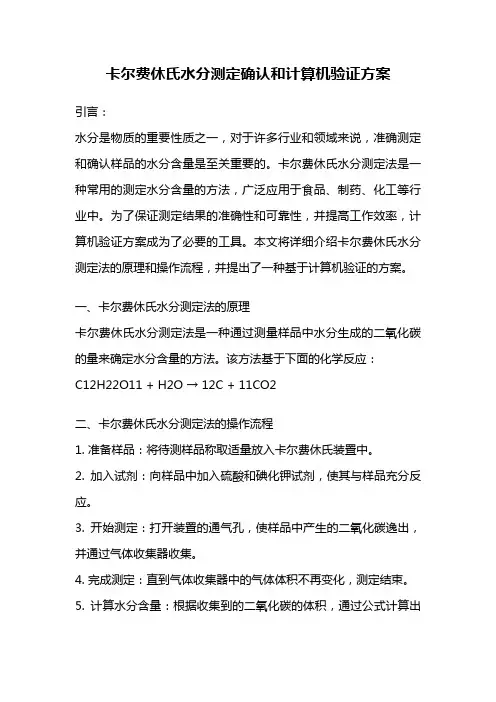
卡尔费休氏水分测定确认和计算机验证方案引言:水分是物质的重要性质之一,对于许多行业和领域来说,准确测定和确认样品的水分含量是至关重要的。
卡尔费休氏水分测定法是一种常用的测定水分含量的方法,广泛应用于食品、制药、化工等行业中。
为了保证测定结果的准确性和可靠性,并提高工作效率,计算机验证方案成为了必要的工具。
本文将详细介绍卡尔费休氏水分测定法的原理和操作流程,并提出了一种基于计算机验证的方案。
一、卡尔费休氏水分测定法的原理卡尔费休氏水分测定法是一种通过测量样品中水分生成的二氧化碳的量来确定水分含量的方法。
该方法基于下面的化学反应:C12H22O11 + H2O → 12C + 11CO2二、卡尔费休氏水分测定法的操作流程1. 准备样品:将待测样品称取适量放入卡尔费休氏装置中。
2. 加入试剂:向样品中加入硫酸和碘化钾试剂,使其与样品充分反应。
3. 开始测定:打开装置的通气孔,使样品中产生的二氧化碳逸出,并通过气体收集器收集。
4. 完成测定:直到气体收集器中的气体体积不再变化,测定结束。
5. 计算水分含量:根据收集到的二氧化碳的体积,通过公式计算出样品中的水分含量。
三、卡尔费休氏水分测定法的确认为了确保卡尔费休氏水分测定法的准确性和可靠性,需要进行确认实验。
确认实验的主要内容包括以下几个方面:1. 准确性:通过测定标准样品的水分含量,验证卡尔费休氏水分测定法的准确性。
2. 精密度:通过重复测定同一标准样品的水分含量,验证卡尔费休氏水分测定法的精密度。
3. 线性:通过测定一系列不同水分含量的标准样品,验证卡尔费休氏水分测定法的线性关系。
4. 选择性:通过测定不同样品的水分含量,验证卡尔费休氏水分测定法对不同样品的适用性。
四、计算机验证方案的设计为了提高工作效率和数据处理的准确性,可以采用计算机验证方案。
计算机验证方案的主要步骤包括以下几个方面:1. 系统设计:根据卡尔费休氏水分测定法的原理和操作流程,设计相应的计算机软件或程序。
卡尔费休水分测定仪标准卡尔费休水分测定仪是一种广泛应用于粮食、饲料、食品、木材、化工等行业的专业仪器,用于快速准确地测定样品中的水分含量。
本文将对卡尔费休水分测定仪的标准进行介绍和解读,以便用户能够更好地理解和使用该仪器。
一、仪器工作原理卡尔费休水分测定仪基于卡尔费休方法,该方法是通过测量样品中水分的蒸发热量来确定水分含量的一种常用方法。
仪器通过加热、蒸发、冷凝、计量等步骤,使样品中的水分蒸发,并通过水蒸气的冷凝和重量变化来计算水分含量。
该方法精度高、速度快、操作简便,因此在各个行业得到了广泛应用。
二、仪器性能指标1. 测量范围:卡尔费休水分测定仪的测量范围应满足使用者的需求,常见的仪器测量范围为0-100%。
2. 精度:仪器的测量精度应满足行业标准或用户要求,常见的精度要求为±0.1%。
3. 重复性:仪器的测量重复性指标应满足行业标准或用户要求,常见要求为相对标准偏差不大于1%。
4. 加热速度:仪器的加热速度应满足用户的需求,一般为不超过10分钟。
5. 试样量:仪器的试样量应适宜,一般为5-10克。
三、仪器操作要点1. 样品准备:根据待测样品的特点,选择适当的样品准备方法,如研磨、过筛等。
2. 称量样品:按照仪器要求,准确称取样品,并记录样品的质量。
3. 仪器预热:打开仪器电源,按照操作手册要求进行预热,确保仪器处于正常工作状态。
4. 校准仪器:根据仪器说明书,对仪器进行校准,确保仪器的准确性和可靠性。
5. 加热测定:将样品装入卡尔费休水分测定仪中,按照仪器操作手册要求进行加热测定,记录测定结果。
6. 数据处理:根据仪器测得的水分含量,按照标准方法或用户要求进行数据处理,如取平均值、计算相对标准偏差等。
7. 仪器维护:测定结束后,及时清洁仪器,保持仪器的良好状态,延长仪器使用寿命。
四、仪器应用领域卡尔费休水分测定仪广泛应用于以下各行业:1. 粮食行业:用于粮食、油料、豆类等农产品的质量检验,保障食品安全。
JJG 中华人民共和国国家计量检定规程JJGXXX—2006卡尔·费休库仑法微量水分测定仪Instruments for KF coulometry titration2006—XX—XX发布2006—XX—XX实施国家质量技术监督局发布本规程经国家质量监督检验检疫总局于200X 年XX 月XX 日批准,并自200X 年XX 月XX 日实施。
归口单位:国家物理化学计量技术委员会 起草单位:山东省计量科学研究院 参加单位:淄博华坤电子仪器有限公司本规程委托国家物理化学计量技术委员会负责解释卡尔·费休库仑法微量水分测定仪Verification Regulation ofInstrument for KF coulometry titrationJJGXXX-200X本检定规程主要起草人:王乐新(山东省计量科学研究院)林振强(山东省计量科学研究院)王云(山东省计量科学研究院)参加起草人:赵玮(淄博华坤电子仪器有限公司)目录1范围 (4)2概述..........................................................................................(4)_ 3通用技术要求 (5)3.1仪器外观 (5)3.2通电检查 (5)4计量性能要求 (5)5计量器具控制 (6)5.1检定条件 (6)5.2检定设备 (6)5.3标准物质 (6)6 检定项目和检定方法 (6)6.8 安全指标.............. .. (8)6.9 检定结果处理和检定周期 (8)附录A 微量注射器的校准 (9)附录B 微量水分测定仪检定原始记录 (10)附录C 检定证书 (背面)格式 (12)附录D 检定结果通知书(背面)格式 (13)微量水分测定仪检定规程1 范围本规程适用于卡尔·费休微量水分测定仪(库仑法)的首次检定、后续检定和使用中检验。
关于卡尔·费休容量法水分测定仪测量结果的不确定度评定作者:***来源:《科学与信息化》2020年第08期摘要卡尔·费休容量法水分测定仪是一种广泛应用于测定化工、医药、轻工、食品等行业产品水分的精密测量仪器。
为了保证企事业、科研单位生产、检验、研究工作的顺利准确进行,推动经济更高质量的发展。
正确有效地对卡尔·费休容量法水分测定仪检定示值相对误差进行不确定度评定就显得尤为必要。
检定该仪器的主要标准器为液体水分标准物质。
文章具体以V20型卡式水分测定仪为例进行示值误差不确定度的评定。
考虑计量标准器的不确定度和环境条件的影响、人员操作的影响、被检仪器分辨力影响等进行合成计算,结论以扩展不确定度表示(k=2)。
关键词水分测定仪;相对示值误差;不确定度概述卡尔·费休容量法水分测定仪主要用于检测石油、化工、医药、食品和电力等行业产品中水分的含量。
其反应的基本原理是:在非水溶剂体系中,碘、二氧化硫和微量水按照物质的量1:1:1的比例反应。
反应式为CH3OH+SO2+I2+H2O+3RN=[RNH]SO4CH3+2[RNH]I。
仪器的主要构成部分包括滴定池、滴定管、指示电极、搅拌系统和控制系统。
样品的水分含量可以根据卡尔·费休滴定剂的滴定度和消耗体积,以及样品的质量计算得到。
样品水分含量%,其中T为滴定剂的滴定度,单位为mg/ml,V为滴定剂的体积,单位为ml,m为样品质量,单位为g。
测量依据:JJG1154-2018 《卡尔·费休容量法水分测定仪检定规程》环境条件:温度:(10~30)℃ ;相对湿度:≤80%;无强烈电磁干扰源测量标准:中国计量科学研究院生产的液体水分标准物质GBW13512,其标准值为1.000×10-2(质量分数),其扩展不确定度为0.013×10-2,k=2,梅特勒-托利多生产的电子天平AL204,准确度等级Ⅰ级,测量范围为0~210g,其分度值为0.1mg。
卡尔费休V30S水分仪操作规程一、操作方法1、浓度标定:1)开机进入主界面后,发现管道内有气泡,点击“冲洗”快捷键,排净里面的气泡后;2)待气泡排净后,点击“排液”快捷键,将无水甲醇排至废液瓶;(若无气泡,省去1)3)点击“加液”快捷键加入无水甲醇50mL左右停止;4)点击方法的快捷键(或者在方法里找到测试样品的方法,点击“开始”来启动方法)。
进入方法分析界面后,在此输入样品的信息,如样品批次、数量等。
点击“开始”来运行方法。
5)方法运行后首先会自动进入“预滴定”状态,用于除去溶剂里的水分,使滴定杯保持一种干燥状态。
此时“开始样品”键呈灰色状态。
预滴定完成后,仪器就会保持在待机状态下,此时“开始样品”键变亮,点击“开始标定”进行卡尔费休浓度的标定。
6)标定时,待机平衡时加入10uL纯净水标定两次,两次结果相对偏差小于1%时,标定完成。
2、样品测试操作:1)按照仪器的提示现象滴定杯内添加水标样,然后点击“确定”键。
按照提示输入所添加样品的质量(质量精确到0.0001g)点击“确定”,回到测试样品的界面。
若难以估计样品进量,可以先按“其他”按键,根据提示输入样品水分含量,,从而计算出样品量,再根据计算出的样品量,打进规定量的样品(打入液体时贞观不能伸至液面以下)。
2)在测试样品的界面可以看到试样测试的状态,滴定结束后,仪器会自动显示结果。
此时可以看到样品浓度,再点击“确定”键,仪器又会回到待机界面。
二、注意事项1、此仪器只用于可溶于甲醇类液体分水测定。
2、干燥剂每隔一段时间用马弗炉350-400℃烘干2h。
3、仪器使用温度5℃-40℃。
4、使用前检查各接口是否拧紧。
5、使用结束后关闭电源。
6、穿戴好防护用品。
卡尔费休水分测定仪检定规程一、卡尔费休水分测定仪检定原理1.仪器状态:分为过碘,过水,正常,测量状态;过碘:反应杯内有过量的碘,需向反应杯内注入微量的水;过水:反应杯内有水,需要电解至平衡;正常:反应杯内无水,仪器处于维持电解终点平衡的状态,可开始进行样品测量。
测量:按开始键,仪器显示测量状态。
AKF-C6微量卡尔费休水分测定仪2.电解速度:通过点击电解速度的值,数值会由0至5循环变化,数值越大,电解速度越快。
可根据卡尔费休的电解能力适当调节,速度过快会影响仪器电解终点平衡,如果仪器状态经常提示过碘,电解值为0.00,则需降低电解速度。
每次更改电解速度,仪器都需要重新电解平衡。
3.电解:当前电解速度显示值,反映当前电解速度的快慢,当仪器处于电解终点平衡的状态,电解值会维持一个较小的数值。
4.测量:当前测量电极的测量值,反映杯内水分的多少,水分越多数值越大。
当反应杯内无水,测量值会稳定在终点平衡值附近。
终点平衡值可在仪器设置界面进行修改。
5.返回:按返回键,返回开机状态,仪器停止电解,同时停止搅拌。
6.参数:设置样品参数,测量结果的含水率会根据样品参数的设置进行换算调整。
该参数可在测量中或测量结束后进行修改。
7.记录:参看测量记录。
8.开始:当仪器状态显示正常,将样品准备好,先按开始键,电解计数值清零,然后在1分钟内注入样品,仪器检测到有水进入杯内后自动开始电解。
9.电解计数值:显示电解水的质量,单位为微克。
二、卡尔费休水分测定仪检定规程1.开机,仪器显示开机界面,点击测量键,仪器进入测量界面,搅拌珠开始搅拌,如果反应杯内含水,仪器状态显示过水,自动开始电解。
2.用‘↑’、‘↓’按键调整搅拌器搅拌速度,使反应杯的电解液形成漩涡,但不能溅到池壁上,此时,如果状态显示过碘并提示:请注入适量纯水。
用50ul的进样器抽取一定量的纯水(新试剂大约需要注入20-50ul 纯水)通过进样旋塞缓慢注入到试剂中。
试剂的颜色由深褐色慢慢变为浅黄色,直到状态变为过水。
KARL FISHER APPARATUS AND ITS PERFORMANCE VERIFICATIONR ICK J AIRAM, R OBERT M ETCALFE, P H.D., AND Y U-H ONG T SE, P H.D. GlaxoSmithKline Canada, Inc.14.1 INTRODUCTIONThe Karl Fisher titration is one of the most common and most sensitive methods used in the analytical laboratory. The titrimetric determination of water is based on the quantitative reaction of water with an anhydrous solution of sulfur dioxide and iodine in the presence of a buffer that reacts with hydrogen ions. This titration is a two-stage process:SO2 + MeOH + RN→(RNH)SO3Me (14.1)(RNH)SO3Me + I2 + H2O + 2RN→(RNH)SO4Me + 2(RNH)I (14.2)where RN is a base, typically pyridine or imidazole. Reaction (14.1) reaches equilibrium and produces methylsulfite as the reaction intermediate. Reaction (14.2) the redox process, is very rapid. From equation (14.2) the direct relation between water and iodine consumption can be seen, which enables the amountof water to be determined. Complete esterification of the sulfur dioxide with the alcohol, and the ability of the base to neutralize the methyl sulfurous acid, arethe key requirements for the reaction above to be stoichiometric.Analytical Method Validation and Instrument Performance Verification, Edited by Chung Chow Chan, Herman Lam, Y. C. Lee, and Xue-Ming ZhangISBN 0-471-25953-5 Copyright 2004 John Wiley & Sons, Inc.221222 KARL FISHER APPARATUS AND ITS PERFORMANCE VERIFICATIONPyridine was used in the beginning of the development of the method. The reaction was slow and the endpoint unstable because of weak basicity of pyridine. The pyridine system buffers at about pH 4. A stronger base, imidazole, has been used to replace pyridine since it gives a faster response and has the advantages of lower toxicity and decreased odor. The optimal pH range for the SO2 imidazole buffer is at pH 6. It is important that the pH of the Karl Fisher reaction be maintained within the range 5 to 7. Outside this recommended pH range, the endpoint may not be reached.There are two types of Karl Fisher titrations: volumetric and coulometric. Volumetric titration is used to determine relatively large amounts of water (1to 100 μg) and can be performed using the single- or two-component system. Most commercially available titrators make use of the one-component titrant, which can be purchased in two strengths; 2 mg of water per milliliter of titrant and the 5 mg of water per milliliter of titrant. The choice of concentration isdependent on the amount of water in the sample and any sample size limitations.In both cases, the sample is typically dissolved in a methanol solution. Theiodine/SO2/pyridine (imidazole) required for the reaction is titrated into the sample solution either manually or automatically. The reaction endpoint is generally detected bivoltametrically.Coulometric titration is used to determine relatively low concentrations ofwater (10 μg to 10 mg) and requires two reagents: a catholyte and an anolyte (the generating solution). The iodine required for the reaction is generated in situby the anodic oxidation of iodide.2I−→I2 + 2e−(14.3)The iodine then reacts with the water that is present. The amount of water titratedis proportional to the total current (according to Faraday’s law) used in generating the iodine necessary to react with the water. One mole of iodine reacts quantitatively with 1 mol of water. As a result, 1 mg of water is equivalent to 10.71 C.Based on this principle, the water content of the sample can be determined bythe quantity of current that flows during the electrolysis. For this reason, the coulometric method is considered an absolute technique, and no standardizationof the reagents is required.14.2 SCOPE OF CHAPTERThe Karl Fisher instrumentation and its performance verification are discussed in this chapter. The instrumentation, calibration practices, and common difficulties that are encountered are presented. Neither method validation nor method specific problems are discussed.14.3 INSTRUMENTATIONKarl Fisher apparatus has to be designed to exclude moisture, deliver titrant, andto detect the endpoint. The air in the system is kept dry with a suitable desiccant, INSTRUMENTATION 223and the titration vessel may be purged by means of a stream of dry nitrogen orair. For endpoint detection, most commercially available units use a bivoltametric method to indicate that the endpoint has been reached. For this method a constant current of about 20 μA is applied across a pair of platinum electrodes that are about 2.5 mm apart. As the titration proceeds, water reacts with iodine and is consumed. When the endpoint is reached and all the water is consumed, thereis a buildup of free iodine in solution. The free iodine causes ionic conductionin the solution. As a result, the voltage must be reduced to keep the polarization current constant [1,2]. When the voltage drops below a defined value, the titrationis stopped. Figure 14.1 shows a schematic diagram of a typical KF titrator.In some cases (see below) a KF drying oven is required to get the water froma sample into the titration vessel. For these special cases, a solid sample (usually)is placed into a specially designed KF oven where the sample is heated, and the water goes into the vapor phase. A stream of dry carrier gas (usually, N2 orair) sweeps the liberated moisture into the reaction vessel, where it is titratedby either the coulometric or the volumetric method. It is critical that the carriergas is dry and that there are no leaks along the pathway to the reaction vessel. Passing the carrier gas over activated molecular sieve prior to the sample will ensure that the gas is dry.The KF reaction depends on free water available for titration. Instruments maybe designed to homogenize the sample to release water prior to the titration. In Magnetic StirrerDouble Pt electrodeMethanol solutionTo pumping systemTubing to deliver titrantI = 20 m AV = variableFigure 14.1. Schematic diagram of a typical Karl Fischer titrator.224 KARL FISHER APPARATUS AND ITS PERFORMANCE VERIFICATIONthis case, a high-speed blender may be used directly in the titration vessel. Thisis a particularly useful accessory for determination of water in tablets or certain food products that are difficult to prepare for analysis.14.3.1 Performance VerificationThe performance verification of Karl Fisher apparatus should include checksfor the accuracy and precision of the instrument. The linearity of the instrument should be determined at installation. The first step is to standardize the instrument (see Section 14.3.2); pure water is sufficient for this purpose. Sodium tartrate dihydrate standard (water content 15.66 ±0.05%) can be used to assess the accuracy, precision, and linearity of the instrument. Typically, one would measure the water content of at least five samples, over the intended instrument user range. For example, the water content of sodium tartrate dihydratesamples that were 65 mg (ca. 10 mg H2O), 195 mg (ca. 30 mg H2O), 325 mg (ca. 50 mg H2O), 455 mg (ca. 70 mg H2O), and 650 mg (100 mg H2O) could be determined. Calculate the percent water to assess the instrument’s accuracy. The results should be within 98 to 102% of 15.66% water. Determine the % RSD of the percent water found to assess the precision of the instrument. The % RSD should be less than or equal to 1%. Finally, plot the expected water content versus the percent water content to assess the linearity of the instrument’s response.A correlation coefficient (r) value of 0.999 or greater is acceptable.14.3.2 StandardizationStandardization should be performed daily, since the titrant will absorb moisture over time. The standardization is typically performed using one of three standards: (1) disodium tartrate dihydrate (15.66% water, w/w), (2) commercially available water standards with a certified concentration of water (typically, 10 mg of water per gram of standard), or (3) pure water. In all of these cases, a suitable balance should be used, preferably one that gives at least ±0. l mg of resolution.When disodium tartrate dihydrate is used, samples ranging from 50 to 120 mg are dissolved in methanol, and the concentration of the KF reagent is determined. Based on volume of titrant used, the weight of the sample and the percent waterin the disodium tartrate dihydrate (15.66% w/w), the standardization factor can be calculated. One pitfall with this method is the solubility of the disodium tartrate dihydrate in methanol. It is recommended that the disodium tartrate dihydrate be finely divided and that a suitable extraction time be given for the solids to dissolve. If a water standard is used, samples of the water standard ranging from 1.0 to1.5 g are injected into the methanol via syringe. This method is best performedby opening the ampoule that contains the water standard, rinsing out a 10-mL syringe with about 1 mL of the standard, and then filling the syringe with the remaining contents of the ampoule. Aliquots of approximately 1 mL are then injected into the vessel, and the true weights are determined by difference. Standardization of the KF titrant using purified water is widely accepted and probably the most commonly used in analytical laboratories. Using a suitable COMMON PROBLEMS AND SOLUTIONS 225glass syringe, a known volume of purified water can be added in the titration vessel, and the KF value for the titrant can be determined. This method is highly operator dependent and is not recommended for measurements where the accuracy of the determination is critical. The preferred method would be to add aknown quantity of water by weight.In the coulometric method, standardization is not necessary, since the current consumed can be measured absolutely. However, a standard with known water content should be checked periodically to ensure that the system is functioning properly. In this case, a certified water standard is generally used, and the amount of water is determined and compared with the amount that is certified to be present. Some coulometric titrators are equipped with an oven for liberating the moisture from samples that are either insoluble in methanol or that react with I2, methanol, or one of the other reagents. Solid standards (e.g., potassium citrate monohydrate) are available for checking the oven, and this check is performed after the coulometer function has been verified.14.3.3 Measurement of SamplesThe handling of the sample, its storage, and the amount of sample used are very important to consider when making a KF measurement. When taking a sample from the bulk material, great care must be taken to exclude atmospheric moisture, which is one of the most common sources of error. If the sample absorbs or desorbs water during its handling, the true moisture content can no longer be determined. The sample must also contain the average amount of water that is contained in the material as a whole. This is a particular problem when dealing with nonpolar liquids such as fats or oils where the water is floating on the top or settled to the bottom of the container. In this situation the liquids must be mixed thoroughly just prior to sampling to disperse the water evenly.Once a sample is taken, it is best to determine the water as quickly as possible.If a sample must be stored, it is best to keep it in a small, tightly sealed glass bottle with a screw cap. Glass is better than plastic since plastic is not water vapor–tight. The size of the bottle should be as small as possible to minimizethe gas space that is above the sample. A smaller gas space will mean lessmoisture vapor.The size of the sample to be used depends on the expected water content andthe degree of accuracy that is desired. If a high level of accuracy is required, a large sample size should be used to minimize the effect of atmospheric moisture. For titrimetric KF, the United States Pharmacopoeia recommends using a sample that will contain between 10 and 250 mg of water. The minimum amount of water is generally agreed to be 10 mg.14.4 COMMON PROBLEMS AND SOLUTIONSAtmospheric moisture is a major cause of error in Karl Fischer titrations. Moisture can enter the sample, titrant, and titration vessel. The apparatus and titrant must 226 KARL FISHER APPARATUS AND ITS PERFORMANCE VERIFICATIONbe sealed against atmospheric moisture and situated away from high-humidity areas of the laboratory. Desiccants and dry purge gases can be used to reduce moisture ingress. Proper conditioning of the apparatus is required to remove moisture present in the apparatus before the titration. Moisture will, however, enter the apparatus during introduction of the sample in a normal lab environment. With high-speed blending, this introduction of moisture can cause bias due to homogenizing air containing water into the sample. To reduce bias when highspeed blending is used, it is necessary to apply background correction or purgethe sample compartment to exclude moisture.The titrant delivery system can also be a source of error. The delivery system needs to be precise in the number of steps required to titrate a fixed amount of water. The delivery of titrant is typically controlled by either a peristaltic pumpor an automatic buret. Both are acceptable methods for the delivery of titrant; however, the peristaltic pump relies on the contact between the pump rollersand the tygon tubing, which is pressed into position by a platen. Therefore, the quality of the tubing that is used is critical to the accuracy of the instrument, so this tubing should be examined frequently to make sure that it is in good working order (free of blockages and not pinched to the point that flow is restricted).The pump rollers should also be examined to make sure that they are operating well, and the platen should be examined to make sure that it holds the tubing tightly against the rollers. The automatic buret is actually a syringe driven bya metered servomotor. For this type of delivery system the key concerns arethat the servomotor is operating properly (i.e., delivering the correct amount of liquid) and that there are no leaks, blockages, or air bubbles in the lines or in the syringe itself.Depending on the samples being titrated, electrode contamination may bean issue. The electrodes may become coated when substances such as oils and sugars are titrated. This results in delayed endpoint detection and an overtitration.A dark brown color on the electrodes indicates that they should be cleaned. The coatings can usually be removed by polar organic solvents or by cleaning the platinum physically.Side reactions can cause major problems in the determination water [3]. Some chemical species react with methanol to produce water that will lead to higherwater results, some react with water (low results), and some react with iodine (high result). Aldehydes and ketones react with methanol to produce acetalsand ketals. Water is a by-product of this reaction, and its production leads to erroneously high water contents:Acetal formation: CH3CHO + 2CH3OH →CH3CH(OCH3)2 + H2O (14.4)Ketal formation : (CH3)2CO + 2CH3OH →(CH3)2C(OCH3)2 + H2O (14.5)This can be remedied by using commercially available one-component reagents that contain 2-methoxyethanol and 2-chloroethanol rather than methanol. In the presence of SO2 and base, aldehydes, undergo what is called the bisulfite addition. REFERENCES 227This reaction consumes water.Bisulfite addition: CH3CHO + H2O + SO2 + NR →HC(OH)SO3(HNR)(14.6)The kinetics of this type of reaction are slow, so this can be avoided by starting the reaction immediately after sample addition.Many samples have redox potentials such that they can be oxidized by iodine. Therefore, the iodine in the titrant may be consumed by readily oxidizable samples that will give a false high value for the water content. Some common substances that can be oxidized by iodine are ascorbic acid, arsenite (AsO2−),arsenate (AsO43−), boric acid, tetraborate (B4O72−), carbonate (CO32−), disulfite(S2O52−), iron(II) salts, hydrazine derivatives, hydroxides (OH−), bicarbonates(HCO3−), copper(I) salts, mercaptans (RSH), nitrite (NO2−), some metaloxides, peroxides, selenite (SeO32−), silanols (R3SiOH), sulfite (SO32−), tellurite(TeO32−), thiosulfate (S2O32−), and tin(II) salts. For situations such as thesewhere the material under analysis reacts with iodine, an oven can be used to liberate the moisture from the sample, which is then carried into the reaction vessel and titrated without interference.REFERENCES1. United States Pharmacopoeia, USP 25, Chapter _921_, Water Determination.2. Fundamentals of the Volumetric Karl Fischer Titration, Mettler Toledo Application Brochure 26.3. Riedel-deHaen Hydranal Manual.。